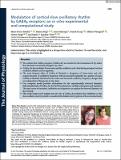Por favor, use este identificador para citar o enlazar a este item:
http://hdl.handle.net/10261/221814COMPARTIR / EXPORTAR:
 SHARE SHARE
 CORE
BASE CORE
BASE
|
|
| Visualizar otros formatos: MARC | Dublin Core | RDF | ORE | MODS | METS | DIDL | DATACITE | |

| Título: | Modulation of cortical slow oscillatory rhythm by GABAB receptors: an in vitro experimental and computational study |
Autor: | Pérez-Zabalza, María; Reig, Ramón CSIC ORCID; Manrique, Jesus; Jercog, Daniel; Winograd, Milena CSIC ORCID; Parga, Néstor; Sánchez-Vives, María V. CSIC ORCID | Fecha de publicación: | 2020 | Editor: | Wiley-VCH | Citación: | Journal of Physiology 598(16): 3439-3457 (2020) | Resumen: | Slow wave oscillations (SWOs) dominate cortical activity during deep sleep, anaesthesia and in some brain lesions. SWOs are composed of periods of activity (Up states) interspersed with periods of silence (Down states). The rhythmicity expressed during SWOs integrates neuronal and connectivity properties of the network and is often altered under pathological conditions. Adaptation mechanisms as well as synaptic inhibition mediated by GABAB receptors (GABAB‐Rs) have been proposed as mechanisms governing the termination of Up states. The interplay between these two mechanisms is not well understood, and the role of GABAB‐Rs controlling the whole cycle of the SWO has not been described. Here we contribute to its understanding by combining in vitro experiments on spontaneously active cortical slices and computational techniques. GABAB‐R blockade modified the whole SWO cycle, not only elongating Up states, but also affecting the subsequent Down state duration. Furthermore, while adaptation tends to yield a rather regular behaviour, we demonstrate that GABAB‐R activation desynchronizes the SWOs. Interestingly, variability changes could be accomplished in two different ways: by either shortening or lengthening the duration of Down states. Even when the most common observation following GABAB‐Rs blocking is the lengthening of Down states, both changes are expressed experimentally and also in numerical simulations. Our simulations suggest that the sluggishness of GABAB‐Rs to follow the excitatory fluctuations of the cortical network can explain these different network dynamics modulated by GABAB‐Rs. | Versión del editor: | https://doi.org/10.1113/JP279476 | URI: | http://hdl.handle.net/10261/221814 | DOI: | 10.1113/JP279476 | ISSN: | 0022-3751 | E-ISSN: | 1469-7793 |
| Aparece en las colecciones: | (IN) Artículos |
Ficheros en este ítem:
| Fichero | Descripción | Tamaño | Formato | |
|---|---|---|---|---|
| 11. JP279476.pdf | 5,6 MB | Adobe PDF |  Visualizar/Abrir |
CORE Recommender
PubMed Central
Citations
9
checked on 21-abr-2024
SCOPUSTM
Citations
15
checked on 24-abr-2024
WEB OF SCIENCETM
Citations
15
checked on 29-feb-2024
Page view(s)
137
checked on 26-abr-2024
Download(s)
127
checked on 26-abr-2024

